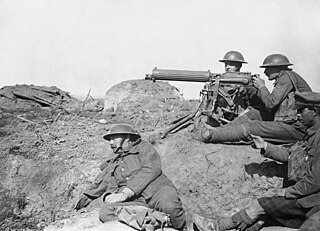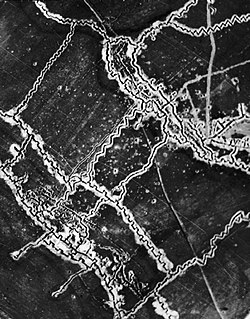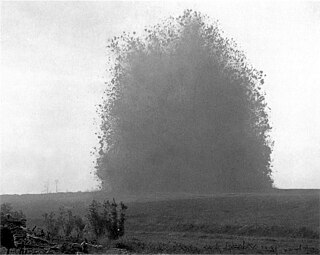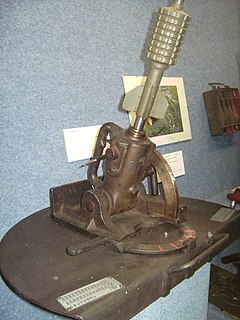This article needs additional citations for verification .(October 2020) |

Trench raiding was a feature of trench warfare which developed during World War I. It was the practice of making small scale night-time surprise attacks on enemy positions.
This article needs additional citations for verification .(October 2020) |

Trench raiding was a feature of trench warfare which developed during World War I. It was the practice of making small scale night-time surprise attacks on enemy positions.
Typically, raids were carried out by small teams of men who would black up their faces with burnt cork before crossing the barbed wire and other debris of no man's land to infiltrate enemy trench systems. The distance between friendly and enemy front lines varied, but was generally several hundred metres. Any attempt to raid a trench during daylight hours would have been pointless because it would have been quickly spotted: enemy machine gunners and snipers had a clear view of no man's land and could easily shoot anyone who showed their head above the trench parapet.

Standard practice was to creep slowly up on the sentries guarding a small sector of an enemy front line trench (looking for the glow of cigarettes in the dark or listening for conversations) then kill them as quietly as possible. Having secured the trench the raiders would complete their mission objectives as quickly as possible, ideally within several minutes. Raiders were aware that the longer they stayed in the trench, the greater the likelihood of enemy reinforcements arriving. Grenades would be thrown into dugouts where enemy troops were sleeping before the raiders left the enemy lines to return to their own.

There was always a risk that returning raiders could be shot in so-called friendly fire incidents. Therefore, it was standard procedure to notify sentries along the line whenever raiding parties were sent out, and to use some form of password system so that returning raiders could identify themselves when challenged in the dark.
Trench raiding had multiple purposes. Typically, the intention would be one or more of the following:
Despite the fact that World War I was the first conflict to be fought by mechanized means, trench raiding was very similar to medieval warfare insofar as it was fought face-to-face with crude weaponry. Trench raiders were lightly equipped for stealthy, unimpeded movement. Typically, raiding parties were armed with deadly homemade trench raiding clubs, bayonets, entrenching tools, trench knives, hammers, hatchets, pickaxe handles and brass knuckles. [1] The choice of weaponry was deliberate: the raiders' intention was to kill or capture people quietly, without drawing attention to their activities. Clearly, this would have been impossible if they had routinely used firearms during raids. Trench raiders were also armed with more modern weapons such as pistols, shotguns, submachine guns, and hand grenades, though these were only intended to be used in an emergency i.e. if the enemy discovered their activities and raised the alarm.

Trench warfare is a type of land warfare using occupied fighting lines largely comprising military trenches, in which troops are well-protected from the enemy's small arms fire and are substantially sheltered from artillery. Trench warfare became archetypically associated with World War I (1914–1918), when the Race to the Sea rapidly expanded trench use on the Western Front starting in September 1914.

Technology during World War I (1914–1918) reflected a trend toward industrialism and the application of mass-production methods to weapons and to the technology of warfare in general. This trend began at least fifty years prior to World War I during the American Civil War of 1861–1865, and continued through many smaller conflicts in which soldiers and strategists tested new weapons.

The Battle of Arras was a British offensive on the Western Front during the First World War. From 9 April to 16 May 1917, British troops attacked German defences near the French city of Arras on the Western Front. The British achieved the longest advance since trench warfare had begun, surpassing the record set by the French Sixth Army on 1 July 1916. The British advance slowed in the next few days and the German defence recovered. The battle became a costly stalemate for both sides and by the end of the battle, the British Third Army and the First Army had suffered about 160,000 casualties and the German 6th Army about 125,000.

Stormtroopers were specialist soldiers of the German Army. In the last years of World War I, Stoßtruppen were trained to use infiltration tactics – part of the Germans' improved method of attack on enemy trenches. The German Empire entered the war certain that the conflict would be won in the course of great military campaigns, thus relegating results obtained during individual clashes to the background; consequently the best officers, concentrated in the German General Staff, placed their attention on maneuver warfare and the rational exploitation of railways, rather than concentrating on the conduct of battles: this attitude gave a direct contribution to operational victories of Germany in Russia, Romania, Serbia and Italy, but it resulted in failure in the West. Thus the German officers on the Western Front found themselves in the need of resolving the static situation caused by trench warfare on the battlefield.

A trench knife is a combat knife designed to kill or incapacitate an enemy at close quarters, such as in a trench or other confined area. It was developed as a close combat weapon for soldiers attacking enemy trenches during the First World War. An example of a World War I trench knife is the German Army's Nahkampfmesser.

Shock troops or assault troops are formations created to lead an attack. They are often better trained and equipped than other infantry, and expected to take heavy casualties even in successful operations.

The Gas Attacks at Hulluch were two German cloud gas attacks on British troops during World War I, from 27–29 April 1916, near the village of Hulluch, 1 mi (1.6 km) north of Loos in northern France. The gas attacks were part of an engagement between divisions of the II Bavarian Corps and divisions of the British I Corps.

Infantry tactics are the combination of military concepts and methods used by infantry to achieve tactical objectives during combat. The role of the infantry on the battlefield is, typically, to close with and engage the enemy, and hold territorial objectives; infantry tactics are the means by which this is achieved. Infantry commonly makes up the largest proportion of an army's fighting strength, and consequently often suffers the heaviest casualties. Throughout history, infantrymen have sought to minimise their losses in both attack and defence through effective tactics.

The Capture of Schwaben Redoubt was a tactical incident in the Battle of the Somme, 1916 during the First World War. The redoubt was a German strong point 500–600 yd (460–550 m) long and 200 yd (180 m) wide, built in stages since 1915, near the village of Thiepval and overlooking the River Ancre. It formed part of the German defensive system in the Somme sector of the Western Front during the First World War and consisting of a mass of machine-gun emplacements, trenches and dug-outs. The redoubt was defended by the 26th Reserve Division, from Swabia in south-west Germany, which had arrived in the area during the First Battle of Albert in 1914. Troops of the 36th (Ulster) Division captured the redoubt on 1 July 1916, until forced out by German artillery-fire and counter-attacks after dark.

Tunnel warfare is a general name for war being conducted in tunnels and other underground cavities. It often includes the construction of underground facilities in order to attack or defend, and the use of existing natural caves and artificial underground facilities for military purposes. Tunnels can be used to undermine fortifications and slip into enemy territory for a surprise attack, while it can strengthen a defence by creating the possibility of ambush, counterattack and the ability to transfer troops from one portion of the battleground to another unseen and protected. Also, tunnels can serve as shelter for combatants and non-combatants from enemy attack.

Trench raiding clubs were homemade melee weapons used by both the Allies and the Central Powers during World War I. Clubs were used during nighttime trench raiding expeditions as a quiet and effective way of killing or wounding enemy soldiers. The clubs were usually made out of wood. It was common practice to fix a metal object at the striking end in order to maximize the injury inflicted. Another common design comprised a simple stave with the end drilled out and a lead weight inserted, with rows of large hobnails hammered in around its circumference. Most designs had some form of cord or leather strap at the end to wrap around the user's wrist. Bosnian soldiers serving in the Austro-Hungarian army were fond of using maces. They were also used by officers to finish enemy soldiers wounded by poison gas attacks.

Wiring parties,, were used during World War I on the Western Front as an offensive countermeasure against the enemy’s barbed wire obstacles. Though hazardous and stressful duty, work was done at night to repair, improve, and rebuild their own wire defences, while also sabotaging and cutting the enemy's. In battles all across the Western Front, cutting parties were successful in creating breaches in the wire lines, offering their comrades a better chance to cross no man's land.
Barbed wire was one of the attacker's great problems. There were cutters, but not enough, and men were often killed before they could cut a way.

Early Germanic warfare was the warfare of early Germanic peoples. It was an important element of early Germanic culture.

Operations on the Ancre took place from 11 January – 13 March 1917, between the British Fifth Army and the German 1st Army, on the Somme front during the First World War. After the Battle of the Ancre, British attacks on the Somme front stopped for the winter. Until early January 1917, both sides were reduced to surviving the rain, snow, fog, mud fields, waterlogged trenches and shell-holes. British preparations for the Battle of Arras, due in the spring of 1917, continued.

The Battle for No.3 Post was fought during the Gallipoli Campaign in the First World War, between the forces of the New Zealand Mounted Rifles Brigade and the Turkish 19th Division.

The Gas attacks at Wulverghem were German cloud gas releases during the First World War on British troops in the municipality of Heuvelland, near Ypres in the Belgian province of West Flanders. The gas attacks were part of the sporadic fighting between battles in the Ypres Salient on the Western Front. The British Second Army held the ground from Messines Ridge northwards to Steenstraat and the divisions opposite the German XXIII Reserve Corps had received warnings of a gas attack. From 21 to 23 April, British artillery-fire exploded several gas cylinders in the German lines around Spanbroekmolen, which released greenish-yellow clouds. A gas alert was given on 25 April when the wind began to blow from the north-east and routine work was suspended; on 29 April, two German soldiers deserted and warned that an attack was imminent. Just after midnight on 30 April, the German attack began and over no man's land, a gas cloud drifted on the wind into the British defences, then south-west towards Bailleul.

The Actions of the Bluff were local operations in 1916 carried out in Flanders during the First World War by the German 4th Army and the British Second Army. The Bluff is a mound near St Eloi, south-east of Ypres in Belgium, created from a spoil heap during the digging of the Ypres–Comines Canal before the war. From 14 to 15 February and on 2 March 1916, the Germans and the British fought for control of the Bluff, the Germans capturing the mound and defeating counter-attacks only for the British to recapture it and a stretch of German front line, after pausing to prepare a set-piece attack.

The Raid on Sidi Haneish Airfield was a military operation carried out the night of 26 July 1942. A British Special Air Service unit commanded by Major David Stirling attacked a German-held airfield in Egypt during the Western Desert Campaign of Second World War. Several Luftwaffe aircraft used to ferry supplies to the Axis forces were destroyed or damaged with machine-gun fire and explosives. Axis front line units were diverted to reinforce the garrisons in the rear vulnerable to attack.

The kleineGranatenwerfer 16 or Gr.W.16(Small Grenade Launcher Model 1916) in English, was an infantry mortar used by the Central Powers during the First World War. It was designed by a Hungarian priest named Father Vécer and was first used by the Austro-Hungarian Army in 1915. In Austro-Hungarian service, they received the nickname "Priesterwerfers". In 1916 Germany began producing a modified version under license for the Imperial German Army.